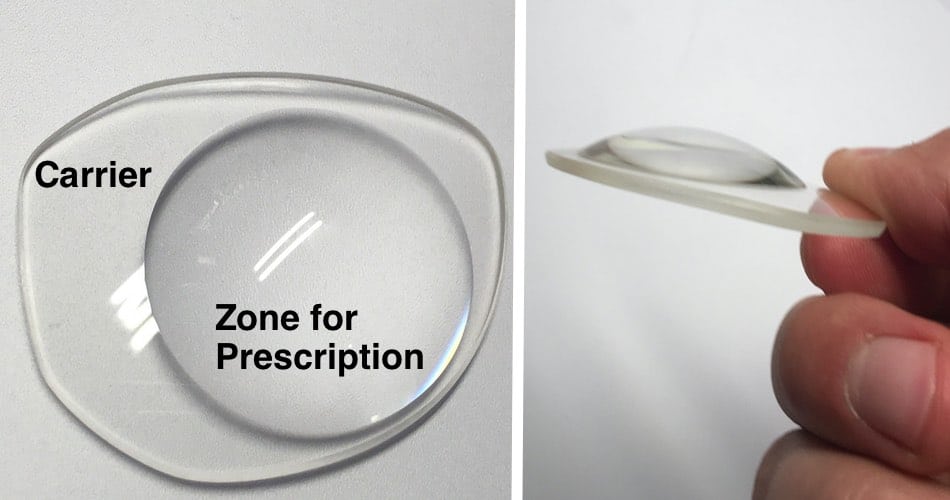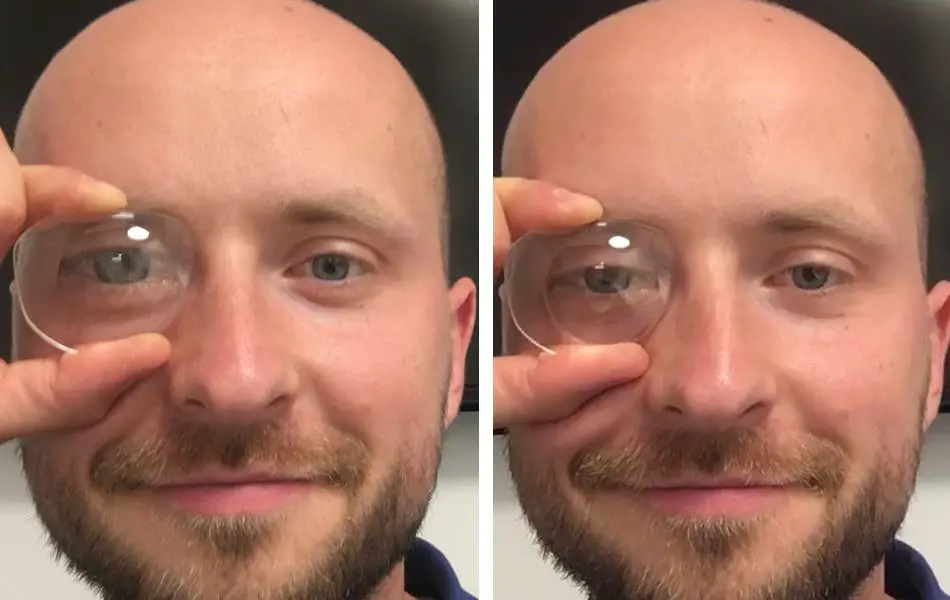Oftentimes when very high lens powers are needed lenticulars can be a valuable choice to reduce weight and thickness. In this article, you will learn about the options you have when it comes to lenticular progressive lenses and what you should consider before buying your new glasses.
Lenticular lenses in general are available in a variety of lens materials. This way the thickness can be reduced even more. You can buy them in glass an in plastic. Depending on the lens design you choose the lens materials will probably change in regard of your optician’s recommendation.
This is why we focus here predominantly on the lens design part. First of all you can get lenticular progressive lenses in an blended fashion or with a visible line.
In both cases, you receive a center in the lens with your prescription for distance vision and reading power outside the zone of your prescription you can find the carrier zone that is just needed to fit the lens into a frame. This way the reduction in thickness can be achieved because the needed diameter in which your prescription is found is a lot smaller.

When we talk about smaller we talk about 30mm compared to 65mm in standard lens design. This diameter can be further reduced or made bigger. Here you can remember one rule. The bigger the zone for your prescription the thicker the lens will be. Of course, you will have a more restricted field of view if you choose to have lenticulars with a very small diameter.
Here for example in the video below you can see an extremely rare case in which the lenticular lenses are definetly very restrictive. But in this case, the lens power is 108 Diopters for a short-sighted customer. This was achieved by the specialty lab from Essilor.
How Does a Lenticular Progressive Lens Look Like?
There is no difference in terms of looks of a lenticular progressive lens and a single vision lenticular lens. Both by the way can look very different. Those differences stem in most cases from the transition from the carrier zone to the zone in which the prescription is built in.

Here in the picture below you can see the differences in the transition from the zone that holds your lens power to the carrier zone. With blended lenticular you will end up without a visible line which would be my personal choice.
When you perform eye movements in the zone where the carrier part is you will experience very blurry vision. Sothere is definetly a tradeoff between weight, your clear field of view and thickness of the lenses.

When adding the reading power to a lenticular lens design you need to calculate in approximately 18 mm from the point you are looking through in the distance to the full reading support in the lower half of the lenses.
So your view will be more restricted with lenticular progressive lens design compared to a single vision lenticular lens design.
Problems With Very High Lens Powers and Progressive Lenses
In my experience oftentimes the amount of lens-owner needed in with very high lens powers oftentimes comes with a bigger imbalance compared to people with lower myopia or hyperopia. Lets say the needed lens power looks like this:
Right Lens: -21
Left Lens: -18
When the left and right eye has a difference that big (usually bigger than 1,5 Diopters) the picture gets heavily deviated. This means the left eye sees the picture a little higher or lower compared the right eye. This imbalance is usually a problem and can cause headaches or double vision.
Those problems only occur if the eyes play together well and you are using them simultaneously. If only one eye is used at a time this imbalance will not play a role as you switch to progressives lenticular lenses.

When you buy glasses with such high lens powers the utmost attention should be placed from your optician in regards to the adjustment of your glasses. Every millimeter counts in which the lens is placed closer to your eye.
The closer the distance from the back surface to your eye the lower the magnifying effects of the lenses will be. In addition to that, the lenses are only made for one exact distance. When the glasses slide down on your nose 3mm you will end up with a blurry vision.
The same is true for angles in which the lenses sit in front of your eyes. Only one position is perfect. If the lenses are more tilted or less tilted than the ideal angle you will end up again with blurry vision. Here I mention this because when you add the reading power in lenticular lenses in a progressive lens design those things get even more relevant.
Because as with every progressive lens design you add blurry zones on the left and on the right in the lower half of the lenses with a clear corridor for reading in the middle. When the position like the tilt is not correctly adjusted the clear corridor gets minimized or can even vanish completely. There is just less room for tolerance here.
The normal range in which normal lenses are available in progressive designs can definitely be expanded to higher prescriptions with lenticular progressive lenses. But the available power range for the lenses is highly dependable on the lens design you saw above in combination with the chosen lens material. Normal progressive lenses are oftentimes available up to 16 Diopters.
I personally would always recommend getting in touch with a specialty lab after we measured everything in our shop. Only then it can be said what can be delivered and what not.
Options When Buying Lenticular Progressive Lenses
When it comes down to the ordering process of lenticular progressive lenses the available options are usually fewer numbers compared to normal progressive lenses. In most cases, you will find those options.
- Length of corridor
- The diameter of your lenticular lens
- The lens material
The Length of the Progression Corridor and What It Influences for You
As with normal progressive lenses you can make the lens design longer or shorter. This means with a short design you do not need to look down as much to reach full reading support. In a long progressive lens design you need to look down more to be able to use the lens power for reading.
This sounds very simple at first and in most cases people would tend to use the shorter lens. But it comes with a drawback. As we mentioned above every progressive lens comes with blurry zones. Those blurry zones become even more dominant as you order a shorter lens.
In addition to this if you have a very short transition from distance vision to reading distance you will end up with an even smaller portion of the lens for the mid distance. This is definetly not good as you plan to use your laptop with your new lenticular progressive lenses.
Even with long progressive lenses, the Clear field of view will be restricted as you look on the screen on your laptop. In most cases when looking at a mid-sized laptop screen, you will see a third of the screen clear in the middle.
The left and right will be blurry. So if you need the mid-distance. Choose a longer lens. If you have a prescription that requires you to wear a stronger lens on one eye compared to the other go with shorter lens designs.
The diameter of your lenticular lens
You can make the diameter for your prescription in the lens smaller or bigger. But in some cases when you go quite small with your diameter the lenses can feel a bit to restricted. See this example here below in the right.

Sure this leads to thinner lenses but look at the darker blue zone. It is bigger on the left and in the middle compared to the right one.
Choosing the Right Lens Material for Your Lenticular Lenses
The lens materials are not created equal. This is why there are thinner and thicker lens materials. In most cases people tend to say they would like to have the thinnest materials available. In a glass lens this is the index 1.9 and in plastic lenses this means the material 1.74 or 1.76.
But oftentimes people tend to notice the drawbacks with extremely thin materials like color fringes. This is more common with the thinnest materials. This is why I always recommend to also calculate the thickness of the lens material which is slightly thicker.
If it delivers a better visual experience and if the thickness does not change much I would prefer the lenses with better optics. In plastic lenses, this would be 1.67 and in the glass material, it is 1.8.
Think about what you want to do with your glasses?
When you come to your optician and you want to buy lenticular progressive lenses you should know a progressive lens is great for having every distance clear. But a progressive lens is always a compromise because of the restricted view. If you work long hours on a desktop PC you might get another pair of computer progressives.
Because if you are over 50 you will probably wiping your head back when using a PC. Of ycourse over an extended amount of time this weird position your neck stays in will lead to problems. This is why should have a second pair of glasses in mind when your lenticular progressive lenses will not fit to get you the visual comfort you expected.
I wish you a great day.
